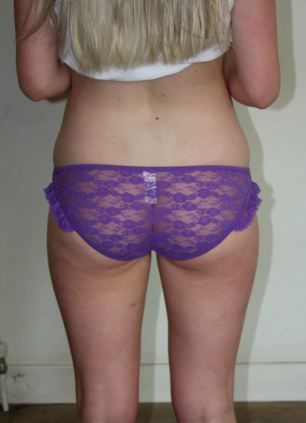With more of us working behind desks than ever before, our bottoms are getting bigger – a problem that has been dubbed ‘desk derriere’.
A recent study that scanned the buttocks of inactive people found muscle was shrinking and breaking down due to lack of exercise.
The research at Tel Aviv University also showed that fat cells thrive in the buttocks of those who lead a sedentary lifestyle, causing thick layers of fat to develop deep inside muscle tissue.

The hip flexor muscles, found at the front of the hip, become overactive and tight if an individual spends all day sitting.
In response, the three key muscles that give the buttocks their shape – the gluteus maximus, gluteus medius and gluteus minimus – become less responsive and generally underactive, leading to poor muscle tone. The gluteal muscles are necessary for stabilising and controlling movement of the pelvis, legs and lower back. When the bottom and stomach muscles become weak and the hip flexor muscles become tight, Lower Crossed Syndrome can develop. Symptoms include lower back, knee or ankle pain and in some cases limited movement.
The flat width of an office bottom may also be attributed to the length of time spent sitting.
The Tel Aviv study showed that preadipocyte cells – the precursor to fat cells – that were exposed to sustained mechanical loading, such as being sat on, developed into fat cells and accumulated fat twice as quickly as normal fat cells.
‘The results suggest that if you sit down for a long time, you are more likely to store fat in your bottom,’ says Professor Amit Gefen, who oversaw the 2011 study. ‘They also imply that the width of a bottom may be increased by sitting down.
‘When our work was published, many experts contacted me to say that they had seen this phenomenon in obese patients.’
Of course, many overweight people simply have a tendency to store fat in specific places.
Women especially are prone to store fat on the bottom. This is due to an enzyme called lipoprotein lipase, which dictates where fat
Unfortunately, you cannot spot-reduce fat. Luckily, the fat on the buttocks isn’t as metabolically active as that on the stomach – fat that deposits around the waist releases enzymes that contribute to the development of diabetes and cardiovascular disease.
However, it is crucial to cut down on sugar, says nutritional therapist Dr Elisabeth Philipps: ‘Simple carbohydrates lead to the secretion of insulin, which increases the body’s ability to store fat. They also sap energy, so you feel less like exercising.’
Drinking lots of water will also help with fluid retention. Those sitting at desks all day often forget to drink enough. Dehydration may cause you to reach for sugary snacks. Finally it is important to get enough of the right types of fat. You can improve skin elasticity on your bottom with two portions of oily fish a week or an omega-3 supplement.
It is possible to determine whether your gluteal muscles are functioning properly or if you are at risk of developing desk derriere with a simple exercise. Lie flat on your tummy and bend one knee to 90 degrees so that the sole of the foot is facing the ceiling. Keeping the foot facing the ceiling, slowly lift the leg five inches off the ground by squeezing your buttock on that side and then hold it motionless in the air for 30 seconds. You should be able to hold the leg perfectly still, with any sensation of tension being limited to the buttock itself. If the lifted leg shakes a lot with the effort or you feel tension in your hamstrings or lower back, the gluteal muscles are not correctly switching on and engaging.
To release the hip flexor muscles and reactivate the gluteal muscles, give yourself a sports massage. Take a tennis ball and slowly roll over the hip flexor muscles where you feel it to be tight. If it feels tender, hold the ball and apply gentle pressure to the area for about a minute or until the tenderness has diminished.
Do this between five and ten minutes a day, repeating five days a week until there is no tension.
Exercise is crucial because it involves dynamic loading (carrying weight while moving) of the muscle cells, which inhibits fat accumulation and burns stored fat.
by Susan Floyd

